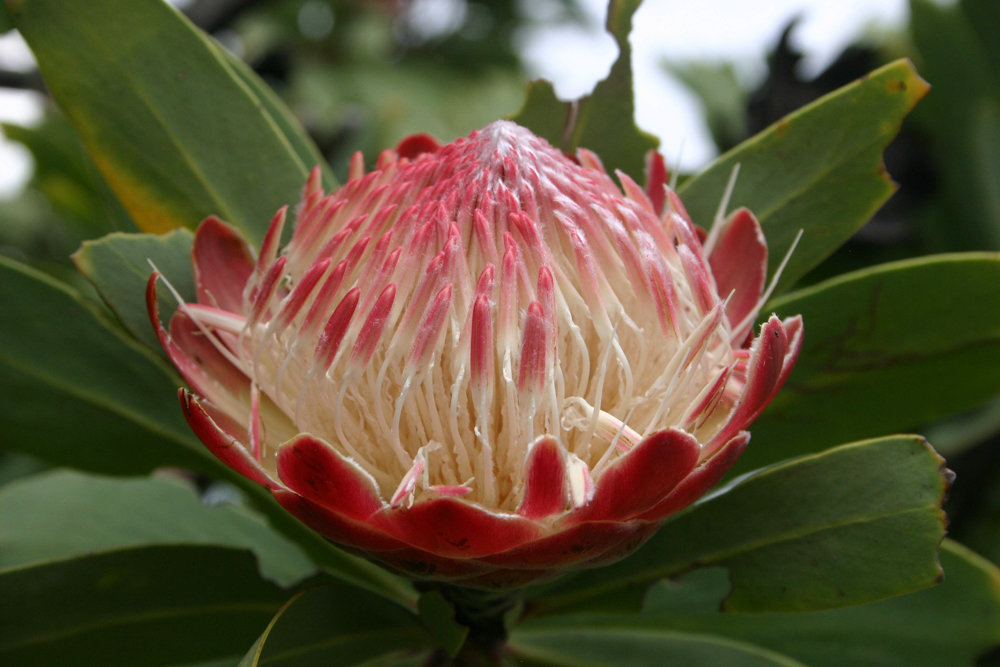Protea plants are ancient mystery we haven’t solved
One day, an instructor brought a bouquet of flowers to a gardening class I was attending. Amongst the more common flowers was something that closely resembled an artichoke, but certainly not the kind that I have encountered on my plate!
This flower would grace any festive occasion.
At the end of class, I was lucky enough to be able to take it home. Upon drying, it continued to be almost as beautiful as when fresh, and I placed it in a vase with other less flamboyant dried flowers. This spectacular flower turned out to be a Protea, a native South African member of the Proteaceae.
Once again, these are names derived from Greek mythology where Proteus was the first-born son of Poseidon, god of the sea. Because of his ability to shape-change, Carl Linnaeus felt the name was particularly apt for a genus in 1735 — and particularly a family — which included a multitude of shapes.
Flowering plants have a lengthy evolutionary history. In 2011, scientists discovered an intact eudicot fossil in China from 125 million years ago they named Leefructus mirus. Eudicots are a specific, more advanced group of flowering plants. Most information on eudicots has been obtained strictly from pollen samples, so having a fairly complete specimen with leaves and a small flower was exciting.
While this specimen is dated only to the mid-Cretaceous, its fully developed form indicates a much earlier origin. Other eudicots include apple and maple trees, dandelions and proteas.
Some 75 genera make up the Proteaceae family. Their distribution in the southern hemisphere is thought to be a result of the breakup of the supercontinent of Gondwanaland into separate landmasses taking their flora along. Ancient Gondwanaland has become the present-day landmasses of Africa, South America, Australia, Antarctica, the Arabian Peninsula and the Indian subcontinent.
The Proteaceae family is widely found particularly in Australia, South Africa, Southeast Asia and Madagascar.
However, recent molecular studies show that some Proteaceae groups found in both Africa and Australia evolved well after the accepted dates for the Gondwanaland breakup. While some seeds of related species in Africa and Australia are aerodynamically capable of being widely distributed by wind or water, some are too heavy to be disbursed by air or water.
The dates for dispersal are millions of years too early for humanity to be a reasonable vector of dispersal. Perhaps bird migrations might have been involved, but this quandary is still unresolved.
We are seldom privy to seeing living examples of ancient flora. Australia, however, has a system of about 50 parks which are now UNESCO Heritage sites, the Gondwana Rainforests. They contain plants that were known to have grown in the lusher areas of Gondwanaland, and represent many of the various stages of plant evolution, including those from the “Age of Pteridophytes” between 359 and 299 million years ago, “Age of Conifers” in the Jurassic Period between 201 and 145 million years ago, and the “Age of Angiosperms” from the Early Cretaceous period of about 145 million years ago, and continuing to the present.
Despite the variability of the Proteaceae, they share certain general characteristics. Many have proteoid roots, also known as cluster roots. These are short, lateral rootlets that form a mat just below the leaf litter during the growing season that shrivel at season’s end. By secreting carboxylate enzymes into low phosphorus soils, they increase access to that mineral.
The increased root surface area also improves water absorption.
Serotiny is a type of seed release that requires some external environmental trigger. And in this case, that trigger is fire.
The seeds are sealed within a cone with a resin that melts in heat and releases the seed. This occurs in poor soils in areas prone to fire.
Fire helps the seed’s growth by clearing out brush and providing an ash layer containing additional nutrients. The chemicals in the smoke itself also seem to aid germination.
Lodgepole pines in the Canadian Rockies are a well-known example, although they are certainly not Proteaceae.
Depending on the species, pollination utilizes a wide variety of animal pollinators including insects (bees and moths), birds (honeyeaters and hummingbirds), and mammals (rodents and bats).
The most spectacular and immediately grabbing aspect of these plants are the flowers, which are formed from a four-part fused cup. The male filamentous stamens are initially fused to the cup in such a way that the filaments are bent over as they grow.
Eventually the flower segments break apart and the stamens spring back forming a border of luminous filaments.
Kirstenbosch National Botanical Garden is located in Capetown, South Africa. It is filled with examples of native Proteas such as P. repens, P. coronata and P. cynaroides. While South Africa is usually a safari destination, these flowers are very special and should not be missed!
Have a thought or comment for Sura Jeselsohn? Email her at greenscenesura@gmail.com.






